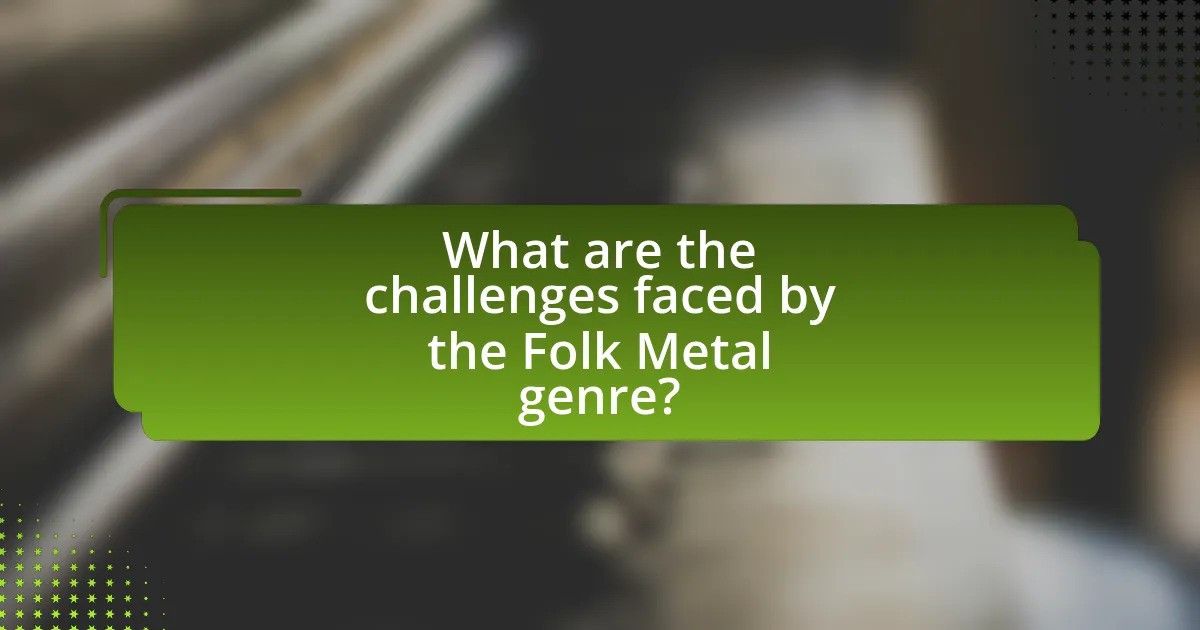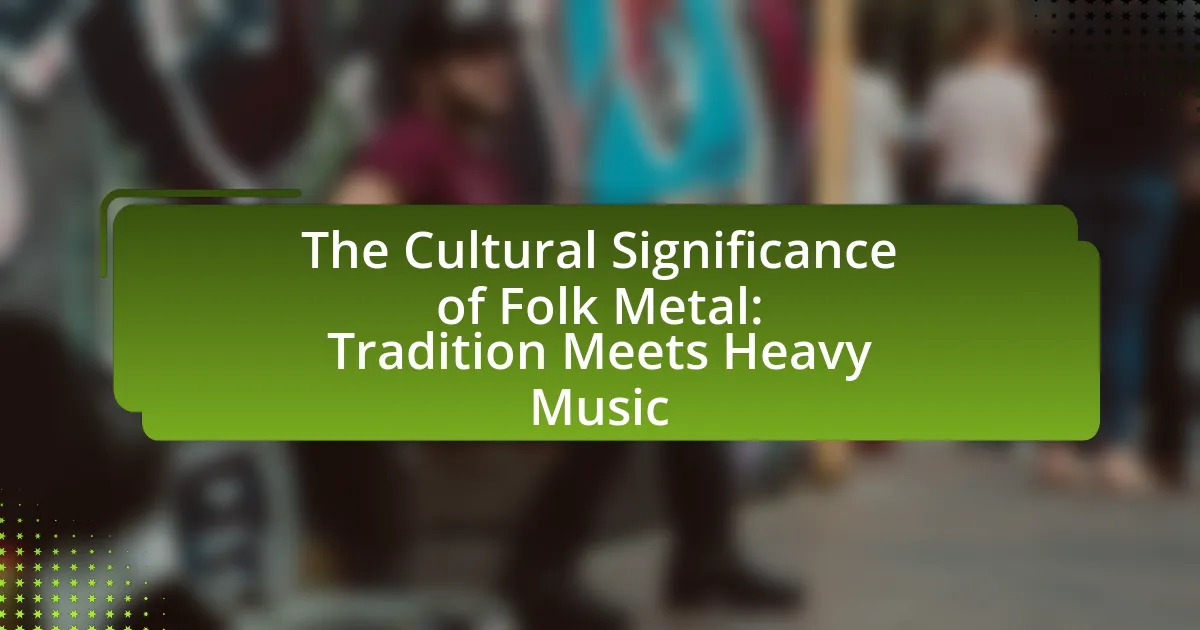Folk metal is a genre that merges traditional folk music with heavy metal, playing a crucial role in celebrating and preserving cultural heritage. This article explores the cultural significance of folk metal, highlighting how it incorporates regional instruments, melodies, and themes that reflect the history and identity of specific communities. It examines the lyrical themes that draw from folklore and mythology, the impact of social movements on the genre’s rise, and the challenges it faces, including commercialization and cultural appropriation. Additionally, the article discusses the future trends in folk metal, emphasizing the importance of global collaboration and technological advancements in shaping its evolution.

What is the Cultural Significance of Folk Metal?
Folk metal holds significant cultural importance as it blends traditional folk music elements with heavy metal, creating a unique genre that celebrates and preserves cultural heritage. This fusion allows for the expression of national identity and folklore, often incorporating regional instruments, melodies, and themes that reflect the history and traditions of specific cultures. For instance, bands like Finntroll and Korpiklaani utilize Finnish and Scandinavian folklore, respectively, to connect listeners with their cultural roots, fostering a sense of community and belonging. Additionally, folk metal often addresses social and political issues relevant to the cultures it represents, making it a vehicle for cultural commentary and preservation.
How does Folk Metal blend traditional music with heavy metal?
Folk metal blends traditional music with heavy metal by incorporating folk instruments, melodies, and themes into the heavy metal framework. This genre often features instruments such as fiddles, flutes, and accordions alongside electric guitars and drums, creating a unique sound that honors cultural heritage while maintaining the intensity of metal. Bands like Finntroll and Korpiklaani exemplify this fusion by using traditional folk melodies and lyrics that reflect folklore and mythology, thus enriching the heavy metal experience with cultural narratives. The combination of these elements not only diversifies the musical landscape but also fosters a sense of identity and community among listeners who resonate with both folk traditions and metal culture.
What instruments are commonly used in Folk Metal?
Folk Metal commonly utilizes traditional instruments such as the violin, flute, accordion, bagpipes, and hurdy-gurdy alongside standard rock instruments like electric guitars and drums. These traditional instruments enhance the genre’s cultural roots and create a unique sound that blends heavy metal with folk music elements. The incorporation of these instruments is evident in bands like Finntroll and Korpiklaani, which showcase how traditional melodies and rhythms are integrated into a heavier musical framework, reinforcing the genre’s connection to cultural heritage.
How do lyrical themes reflect cultural traditions in Folk Metal?
Lyrical themes in Folk Metal reflect cultural traditions by incorporating historical narratives, folklore, and regional myths into their songs. This genre often draws from specific cultural elements, such as ancient battles, local legends, and traditional customs, which serve to preserve and celebrate the heritage of a community. For example, bands like Finntroll and Eluveitie utilize lyrics that reference Scandinavian and Celtic mythology, respectively, thereby reinforcing cultural identity and continuity. The use of native languages in lyrics further enhances this connection, allowing for a deeper resonance with cultural roots and fostering a sense of belonging among listeners.
Why has Folk Metal gained popularity in recent years?
Folk Metal has gained popularity in recent years due to its unique blend of traditional folk music elements with heavy metal, appealing to diverse audiences. This genre resonates with listeners seeking authenticity and cultural connection, as it often incorporates regional instruments and themes, reflecting local traditions and stories. The rise of social media and streaming platforms has facilitated the discovery of niche genres like Folk Metal, allowing bands to reach wider audiences. Additionally, festivals dedicated to Folk Metal have increased, showcasing the genre and fostering community among fans.
What role does nostalgia play in the appeal of Folk Metal?
Nostalgia plays a significant role in the appeal of Folk Metal by evoking a sense of connection to cultural heritage and shared memories. This genre often incorporates traditional melodies, instruments, and themes that resonate with listeners’ past experiences, fostering a feeling of belonging and continuity. For instance, bands like Finntroll and Eluveitie utilize folk elements that reflect historical narratives and folklore, which can trigger personal and collective memories associated with cultural identity. This emotional engagement enhances the listening experience, making Folk Metal not just music, but a medium for cultural expression and reminiscence.
How do social movements influence the rise of Folk Metal?
Social movements significantly influence the rise of Folk Metal by fostering a cultural environment that values traditional music and identity. The resurgence of interest in folk traditions, often driven by movements advocating for cultural preservation and nationalism, has led to a blending of these elements with heavy metal music. For instance, the 1980s and 1990s saw a rise in nationalist movements in various European countries, which encouraged musicians to explore and incorporate their cultural heritage into their art. Bands like Finntroll and Korpiklaani emerged during this period, using traditional instruments and themes that resonate with the sentiments of these movements. This integration of folk elements into metal not only reflects the social context but also serves as a means of expressing cultural pride and resistance against globalization, thereby solidifying Folk Metal’s place in the music scene.

How does Folk Metal reflect cultural identity?
Folk metal reflects cultural identity by integrating traditional folk music elements with heavy metal, creating a unique sound that embodies the heritage and stories of specific cultures. This genre often incorporates regional instruments, melodies, and themes that resonate with the historical and social contexts of the communities it represents. For instance, bands like Finntroll and Korpiklaani use Finnish folklore and mythology in their lyrics and musical compositions, which not only preserve these cultural narratives but also promote a sense of belonging among listeners. Additionally, folk metal festivals often celebrate local customs and traditions, further reinforcing the connection between the music and cultural identity.
In what ways does Folk Metal serve as a cultural expression?
Folk Metal serves as a cultural expression by blending traditional folk music elements with heavy metal, allowing for the preservation and celebration of cultural heritage. This genre often incorporates regional instruments, melodies, and themes that reflect the history and identity of specific communities, such as the use of bagpipes in Scottish Folk Metal or fiddles in Scandinavian variants. Additionally, the lyrics frequently draw from folklore, mythology, and historical narratives, reinforcing cultural storytelling and communal values. For instance, bands like Finntroll and Korpiklaani utilize Finnish folklore in their music, creating a sense of belonging and cultural pride among listeners. Thus, Folk Metal not only entertains but also acts as a medium for cultural continuity and expression.
How do regional variations in Folk Metal showcase local traditions?
Regional variations in Folk Metal showcase local traditions by integrating indigenous musical styles, instruments, and themes that reflect the cultural heritage of specific areas. For instance, Scandinavian Folk Metal often incorporates traditional Nordic melodies and instruments like the Hardanger fiddle, while Celtic Folk Metal features elements such as Irish folk tunes and the use of instruments like the tin whistle. These variations not only highlight the unique folklore and mythology of each region but also serve to preserve and promote local customs and narratives through the medium of heavy music. This connection to local traditions is evident in bands like Finntroll from Finland, which draws on Finnish mythology, and Eluveitie from Switzerland, which emphasizes Swiss folklore, demonstrating how Folk Metal acts as a vehicle for cultural expression and identity.
What impact does Folk Metal have on cultural preservation?
Folk Metal significantly impacts cultural preservation by revitalizing traditional music and folklore within contemporary contexts. This genre often incorporates regional instruments, melodies, and themes that reflect the cultural heritage of specific communities, thereby fostering a sense of identity and continuity. For instance, bands like Finntroll and Korpiklaani utilize Finnish and Sámi folklore in their lyrics and compositions, which not only entertains but also educates listeners about their cultural narratives. Furthermore, Folk Metal festivals and concerts serve as platforms for cultural exchange, allowing diverse audiences to engage with and appreciate these traditions, thus ensuring their survival in modern society.
How do Folk Metal bands engage with their cultural heritage?
Folk Metal bands engage with their cultural heritage by incorporating traditional instruments, melodies, and themes from their native cultures into their music. This genre often features instruments like flutes, fiddles, and bagpipes, which are emblematic of specific cultural backgrounds, enhancing the authenticity of their sound. Additionally, lyrics frequently draw from folklore, mythology, and historical narratives, reflecting the band’s cultural identity and storytelling traditions. For instance, bands such as Finntroll and Korpiklaani utilize Finnish and Sámi folklore, respectively, to create a connection with their roots, thereby preserving and promoting their cultural heritage through modern music.
What are some notable Folk Metal bands and their cultural influences?
Notable Folk Metal bands include Finntroll, Korpiklaani, and Eluveitie, each drawing from distinct cultural influences. Finntroll incorporates Finnish folklore and mythology, blending black metal with traditional Finnish polka, which reflects the country’s cultural heritage. Korpiklaani emphasizes Finnish traditions and rural life, using folk instruments to create a sound that celebrates nature and community. Eluveitie, hailing from Switzerland, integrates Celtic themes and ancient Gaulish history into their music, often using traditional instruments like the hurdy-gurdy, which connects listeners to their Celtic roots. These bands exemplify how Folk Metal serves as a medium for cultural expression and preservation.
How do live performances contribute to cultural significance in Folk Metal?
Live performances significantly enhance the cultural significance of Folk Metal by creating a communal experience that celebrates and preserves traditional folklore and music. These events often feature costumes, instruments, and rituals that reflect the cultural heritage of the communities represented, fostering a sense of identity among attendees. For instance, bands like Korpiklaani and Finntroll incorporate traditional melodies and themes from their respective cultures, which are showcased during live shows, reinforcing the connection between the music and its cultural roots. Additionally, the interactive nature of live performances allows audiences to engage with the music and each other, creating a shared cultural moment that strengthens community bonds and promotes the continuation of folk traditions within a modern context.

What are the challenges faced by the Folk Metal genre?
The Folk Metal genre faces several challenges, including niche market limitations, cultural appropriation concerns, and the difficulty of balancing traditional elements with modern musical trends. The genre often struggles to gain mainstream recognition due to its specific cultural roots and the relatively small audience compared to more popular genres like rock or pop. Additionally, artists within Folk Metal must navigate the fine line between honoring cultural traditions and avoiding appropriation, which can lead to backlash from communities whose cultures are being represented. Furthermore, as musical tastes evolve, Folk Metal bands may find it challenging to innovate while staying true to their folk influences, risking stagnation in a rapidly changing music landscape.
How does commercialization affect the authenticity of Folk Metal?
Commercialization negatively impacts the authenticity of Folk Metal by prioritizing marketability over cultural representation. As bands seek wider audiences and commercial success, they often dilute traditional elements, leading to a homogenization of sound that strays from the genre’s roots. For instance, the incorporation of mainstream production techniques and themes can overshadow the original folklore narratives and musical styles that define Folk Metal. This shift is evident in the increasing use of polished production and commercialized imagery, which can alienate purists who value the genre’s cultural significance and authenticity.
What criticisms do Folk Metal bands face regarding cultural appropriation?
Folk Metal bands face significant criticisms regarding cultural appropriation, primarily for borrowing elements from various cultures without proper understanding or respect. Critics argue that these bands often exploit traditional music, symbols, and attire from cultures that are not their own, leading to a commodification of cultural heritage. For instance, some Folk Metal groups have been accused of using indigenous motifs and themes superficially, which can dilute their original meanings and significance. This practice raises ethical concerns about the authenticity and representation of the cultures being referenced, as it may perpetuate stereotypes or misinterpretations. Additionally, the lack of engagement with the communities from which these elements are drawn can further exacerbate feelings of cultural insensitivity and appropriation.
How do Folk Metal artists navigate the balance between tradition and innovation?
Folk Metal artists navigate the balance between tradition and innovation by integrating traditional folk melodies and instruments with modern metal elements. This fusion allows them to honor cultural heritage while appealing to contemporary audiences. For instance, bands like Finntroll and Eluveitie incorporate traditional instruments such as the hurdy-gurdy and bagpipes, which enrich their sound and connect to their cultural roots. Simultaneously, they employ heavy guitar riffs and aggressive drumming typical of metal, creating a unique genre that resonates with both folk enthusiasts and metal fans. This approach not only preserves the essence of folk music but also revitalizes it, ensuring its relevance in today’s music scene.
What future trends can be expected in Folk Metal?
Future trends in Folk Metal are expected to include increased genre fusion, with elements from electronic and world music being integrated into traditional folk sounds. This evolution is driven by the genre’s growing popularity and the desire for innovation among artists. For instance, bands like Eluveitie and Korpiklaani have already begun experimenting with diverse musical influences, which reflects a broader trend of blending cultural sounds. Additionally, the rise of digital platforms is likely to facilitate global collaborations, allowing Folk Metal to reach wider audiences and incorporate various cultural elements, further enriching the genre’s diversity.
How might technological advancements influence Folk Metal music?
Technological advancements may significantly influence Folk Metal music by enhancing production quality and expanding accessibility. Improved recording software and digital audio workstations allow artists to create high-fidelity recordings from home studios, which can lead to a more polished sound that blends traditional folk elements with heavy metal. Additionally, streaming platforms and social media enable Folk Metal bands to reach global audiences, facilitating the fusion of diverse cultural influences and promoting collaboration across geographical boundaries. For instance, the rise of platforms like Bandcamp and Spotify has allowed independent Folk Metal artists to distribute their music widely without the need for traditional record labels, thus democratizing the music industry.
What role will global collaboration play in the evolution of Folk Metal?
Global collaboration will significantly enhance the evolution of Folk Metal by facilitating the fusion of diverse musical traditions and styles. This collaboration allows artists from different cultural backgrounds to share their unique instruments, rhythms, and lyrical themes, enriching the genre’s sound and appeal. For instance, collaborations between European Folk Metal bands and musicians from regions like Asia or Africa can introduce new scales and instrumentation, creating innovative compositions that resonate with a broader audience. Historical examples include the integration of traditional Celtic melodies with Middle Eastern musical elements, which has led to the emergence of sub-genres within Folk Metal. Such cross-cultural exchanges not only diversify the music but also promote cultural understanding and appreciation, further solidifying Folk Metal’s place in the global music landscape.
What practical tips can be applied to appreciate Folk Metal?
To appreciate Folk Metal, immerse yourself in its cultural roots by exploring the traditional folk music of various regions, as this genre often incorporates local instruments and melodies. Listening to bands like Finntroll or Korpiklaani can enhance your understanding of how these elements blend with heavy metal. Additionally, attending live performances or festivals dedicated to Folk Metal allows for a deeper connection to the community and its traditions. Engaging with the lyrics, which often tell stories of folklore and history, can also enrich your experience, as many songs reflect cultural narratives and values.



